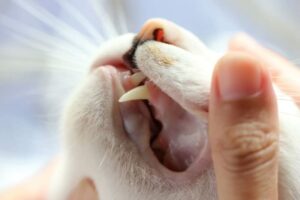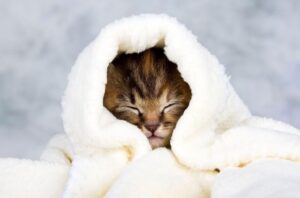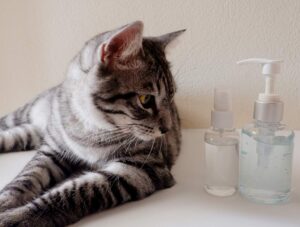Excessive Ear Wax in Cats: What You Need to Know
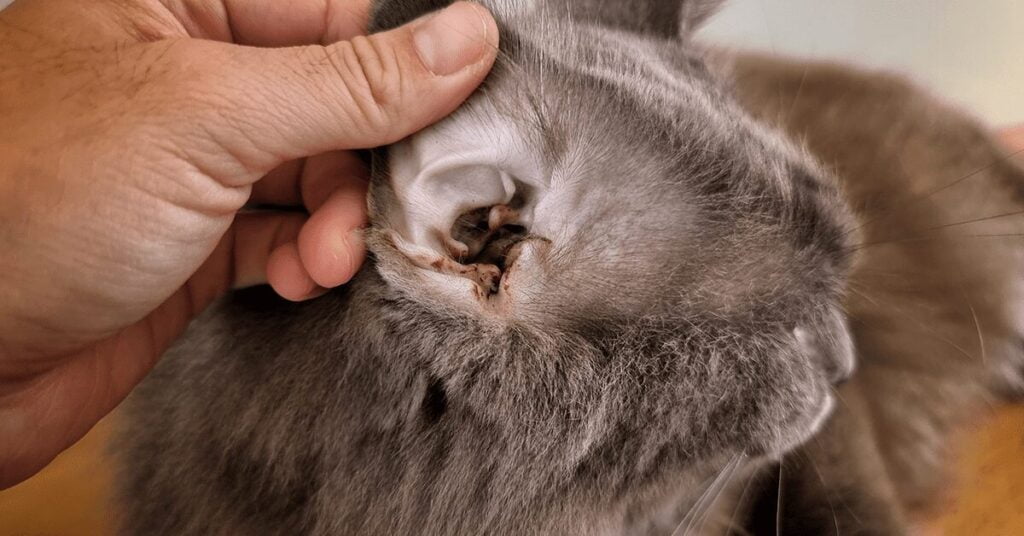
Ear wax is a natural and necessary part of a cat’s ear health (as it is for humans). But when it becomes excessive, it can lead to discomfort and even infections. Understanding the causes and symptoms of excessive ear wax in cats, as well as the proper ways to address it, is crucial for maintaining your feline’s overall well-being.
You may also be mistaking ear wax for discharge, or perhaps the other way around. Don’t worry, we will discuss the causes and symptoms for both!
Generally speaking though, they both overlap quite a bit in terms of symptoms and treatment options. So it’s not that big of a deal.
Symptoms of Excessive Ear Wax in Cats:
A normal healthy cat should have clean and pink inner ears without any (significant) ear wax, black spots, or bad smells. You can gently fold back the outer ear to peer further into the ear canal for a better look. Avoid doing this in a crowded or noisy environment, as your cat may feel uncomfortable with the noise and movement.
If you notice any of the below symptoms in your cat, there is a high probability it is suffering from some sort of medical condition (which causes excessive ear wax).
- Dark or brown waxy buildup in the ears
- Odor coming from the ears
- Itching or scratching at the ears
- Head shaking or tilting
- Redness or swelling in the ears
- Discharge or bleeding from the ears
- Loss of balance or hearing
Causes of Excessive Ear Wax in Cats:
Here is a list of possible causes for the presence of excessive ear wax in cats.
- Overproduction of ear wax: Some cats may simply produce more ear wax than others, making them more prone to excessive ear wax buildup. This may be related to the cat’s genetics, or other factors such as the breed of the cat.
- Allergies: Allergic reactions to certain foods or environmental factors can cause inflammation in the ears, leading to excessive ear wax production.
- Hormonal imbalances: Certain medical conditions, such as hyperthyroidism or diabetes, can cause changes in hormone levels that can lead to excessive ear wax production.
- Ear infections: Bacterial or yeast infections in the ears can cause an overproduction of ear wax. Typically caused due to foreign objects entering the ear, wax build-up, allergies, diseases, or damaged ear drums.
- Ear mites: These are tiny parasites that can infect your cat. They live inside the ear canals, feeding off ear wax and oils and multiplying. Ear mites also stimulate and increase the ear wax production inside your cat, which can cause excessive ear wax. They are also contagious and can easily spread to other cats you might have in your household.
From the above list, Ear mites and Ear infections are the most dangerous and require professional attention ASAP.
If left untreated for too long, these two conditions will just get worse over time. They can cause extreme discomfort to your cat, with severe cases requiring surgery for proper treatment.
The other causes are fairly harmless and can be self-treated at home by regularly cleaning out your cat’s ears to prevent excessive build-up. There are many safe options for cleaning your cat’s ears at home, such as olive oil.
In the case of allergies or hormonal imbalance, you might want to consider some changes to your cat’s diet or environment (after consulting your vet ideally).
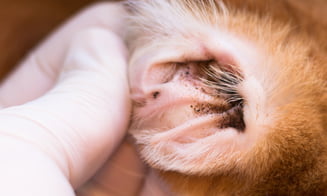
Diagnosing and Solving the Problem
Diagnosing this problem is not easy. For example, Ear mites are so incredibly tiny, you can only see ever them under a microscope. Ear infections are also difficult to distinguish from other potential causes without the right equipment.
With so much uncertainty, it is best to immediately seek professional advice from your veterinarian, who can make sure of specialized equipment to diagnose and resolve the problem.
Only if you are sure that your cat’s ear are dirty from an external source (such as playing around outside), is it ok for you to clean their ears.
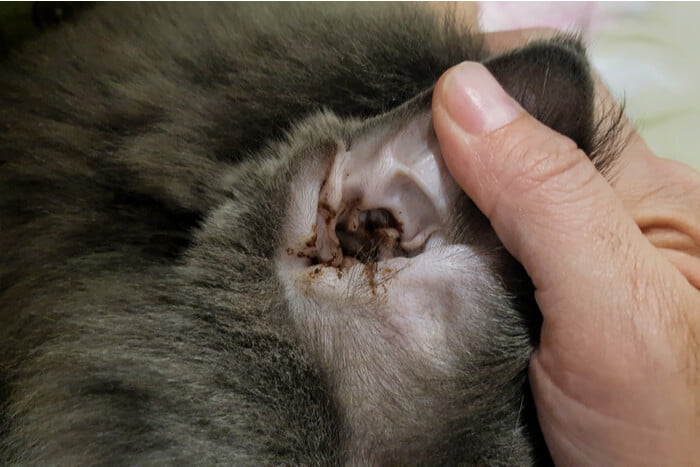
Common Ear-Related Problems (and how to identify them)
Here is the general process of the diagnosis and the corresponding medication/solution for each of the problems we discussed earlier:
Diagnosing Ear Mites: Ear mites are diagnosed by using a microscope to observe if there is a parasite infestation.
Diagnosing Ear Infections: Ear infections are diagnosed by taking a sample of the cat’s ear wax and analyzing it in a lab. Based on this information, the vet will prescribe you either anti-microbial or anti-fungal ear drops. A cleaning solution will also be applied first to clean out the ear.
Hereditary problems: The veterinarian will ask you for the complete medical history of your cat to determine whether there is an underlying medical condition causing this problem. He can then determine whether medication is needed, or whether simple routine cleaning will suffice (which you can do at home).
Allergy test: If all of the above tests fail (generally known as “primary” tests), then the veterinarian will check for allergies. An allergy test is either conducted on the cat’s skin or using samples of the cat’s blood to find the offending substance. This will require changes in the cat’s diet and/or environment to solve.
Ear polyps or tumors: Polyps are a form of benign growth that can occur in the ear canal. Usually needs to be removed forcefully through surgery. Polyps and ear tumors can both result in discharge from your cat’s ears and/or build-up of ear wax.
Prevention Tips for Excessive Ear Wax in Cats:
Taking proactive measures to prevent excessive ear wax buildup in your cat can contribute to their overall ear health. Here are some preventive tips that cat owners can follow:
- Regular Cleaning Routine: Establish a regular ear cleaning routine for your cat. This involves gently cleaning the outer ear and removing any visible dirt or debris. However, it’s important to note that excessive cleaning or using improper cleaning methods can actually lead to more wax production or ear irritation. Consult your veterinarian for guidance on the frequency, technique, and method of cleaning that is appropriate for your cat’s individual needs.
- Keep the Environment Clean: Maintain a clean living environment for your cat. Regularly clean their bedding, toys, and other items they come into contact with to minimize the presence of dirt, dust, and potential allergens. A clean environment can help reduce the risk of ear irritants and allergies that may contribute to excessive ear wax production.
- Identify and Avoid Potential Allergens: Cats can develop allergies to various substances, such as certain foods, pollen, or environmental factors like dust mites. These allergies can cause inflammation in the ears and lead to excessive ear wax. Consult with your veterinarian to identify potential allergens and determine the best approach to manage or avoid them. This may involve dietary changes, environmental modifications, or the use of hypoallergenic products.
- Avoid Excessive Moisture: Excess moisture in the ears can create a favorable environment for bacterial or yeast growth, leading to infections and increased ear wax production. Take precautions to keep your cat’s ears dry, especially after bathing or swimming. Use a gentle, pet-safe drying agent recommended by your veterinarian, and avoid getting water directly into your cat’s ears.
- Minimize Exposure to Ear Mites: Ear mites are a common cause of excessive ear wax in cats. Minimize the risk of ear mite infestation by avoiding contact with other cats or animals that may be infected. If you suspect your cat has been exposed to ear mites, consult your veterinarian for proper diagnosis and treatment.
And that covers it! Hopefully, you understood the process of identifying, diagnosing, and treating a cat with excessive ear wax. Remember to always seek professional advice if your cat is experiencing discomfort, heavy discharge, or blood in the ear canal. Your cat’s safety comes first!
